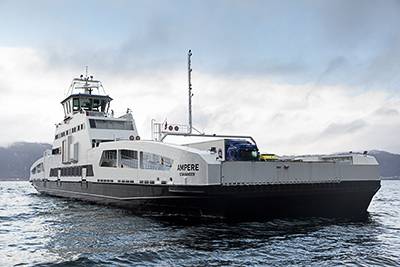Battery-powered Ferry Enters Service in Norway
The world’s first electrical car and passenger ferry powered by batteries has entered service in Norway, representing a milestone on the road to operating emission-free ferries along Norway’s coastline, with at least 50 other routes currently able to sustain battery-operated vessels.
The Norled ferry uses just 150 kWh per route, which corresponds to three days use of electricity in a standard Norwegian household.
Built in conjunction with shipbuilder Fjellstrand, Siemens installed the vessel’s electric propulsion system and put up charging stations with lithium-ion batteries which are charged from hydro power. With the change to battery, shipowner Norled is reducing the cost of fuel by up to 60 percent, Siemens said.
Because the power grid in the region is relatively weak, Siemens and Norled decided to install three battery packs: one lithium-ion battery on board the ferry, and one at each pier to serve as a buffer. The 260-kWh-units supply electricity to the ferry while it waits. Afterward, the battery slowly recoups all of this energy from the grid until the ship comes back again to drop off passengers and recharge. Charging stations are housed in small buildings about the size of newsstands. The ship’s onboard batteries are recharged directly from the grid at night when the ferry is not in use. Each battery pack corresponds to the effect of 1,600 standard car batteries.The Norled ferry will consume around two million kWh per year, whereas a traditional diesel ferry consumes at least one million liters of diesel a year and emits 570 tons of carbon dioxide and 15 metric tons of nitrogen oxides.
On board the ferry, Siemens installed its electric propulsion system BlueDrive PlusC. It includes a battery and steering system, thruster control for the propellers, an energy management system and an integrated alarm system. The integrated automation systems control and monitor the machineries and auxiliaries on the ferry and are connected via Profibus to all other subsystems.
“We are both optimistic and excited about this technology and how it will help shape the future of environmentally friendly maritime technology,” said Mario Azar, CEO of the Siemens Business Unit Oil & Gas and Marine.
Unlike many electric cars, the emission-free ferry was developed from the ground up. The ferry, which is 80 meters long and 20 meters wide, is driven by two electric motors, each with an output of 450 kilowatts. It is made exclusively of light aluminum rather than the steel normally used in shipbuilding. This makes the ferry only half as heavy as a conventional ferry, despite its ten ton batteries and a capacity for 360 passengers and 120 vehicles. An aluminum hull also has double the lifetime as steel hull, which leads to lower maintenance costs.
Ship owner Norled operates on the ferry link across Sognefjord between Lavik and Oppedal, Norway. The fully electric ferry travels six kilometers across the fjord 34 times a day, with each trip taking around 20 minutes. The solution is a result of a competition that Ministry of Transport and Communications and the Norwegian Public Roads Administration launched in 2010. Batteries are expected to become considerably more efficient and less expensive in the next few years, which tip the scales further away from diesel as the most popular fuel source.












